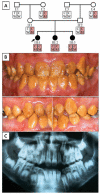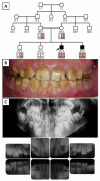Novel WDR72 mutation and cytoplasmic localization
- PMID: 20938048
- PMCID: PMC3144073
- DOI: 10.1177/0022034510382117
Novel WDR72 mutation and cytoplasmic localization
Abstract
The proven candidate genes for amelogenesis imperfecta (AI) are AMELX, ENAM, MMP20, KLK4, FAM83H, and WDR72. We performed mutation analyses on seven families with hypomaturation AI. A novel WDR72 dinucleotide deletion mutation (g.57,426_57,427delAT; c.1467_ 1468delAT; p.V491fsX497) was identified in both alleles of probands from Mexico and Turkey. Haplotype analyses showed that the mutations arose independently in the two families. The disease perfectly segregated with the genotype. Only persons with both copies of the mutant allele were affected. Their hypomineralized enamel suffered attrition and orange-brown staining following eruption. Expression of WDR72 fused to green fluorescent protein showed a cytoplasmic localization exclusively and was absent from the nucleus. We conclude that WDR72 is a cytoplasmic protein that is critical for dental enamel formation.
Conflict of interest statement
The author(s) declare no potential conflicts of interest with respect to the authorship and/or publication of this article.
Figures




References
-
- Andrade MA, Ponting CP, Gibson TJ, Bork P. (2000). Homology-based method for identification of protein repeats using statistical significance estimates. J Mol Biol 298:521-537 - PubMed
-
- Backman B, Holm AK. (1986). Amelogenesis imperfecta: prevalence and incidence in a northern Swedish county. Community Dent Oral Epidemiol 14:43-47 - PubMed
-
- Chosack A, Eidelman E, Wisotski I, Cohen T. (1979). Amelogenesis imperfecta among Israeli Jews and the description of a new type of local hypoplastic autosomal recessive amelogenesis imperfecta. Oral Surg Oral Med Oral Pathol 47:148-156 - PubMed
-
- Deméré TA, McGowen MR, Berta A, Gatesy J. (2008). Morphological and molecular evidence for a stepwise evolutionary transition from teeth to baleen in mysticete whales. Syst Biol 57:15-37 - PubMed
-
- den Dunnen JT, Antonarakis SE. (2003). Mutation nomenclature. Curr Protoc Hum Genet Chapter 7:Unit 7.13 - PubMed
Publication types
MeSH terms
Substances
Grants and funding
LinkOut - more resources
Full Text Sources
Molecular Biology Databases
Miscellaneous

